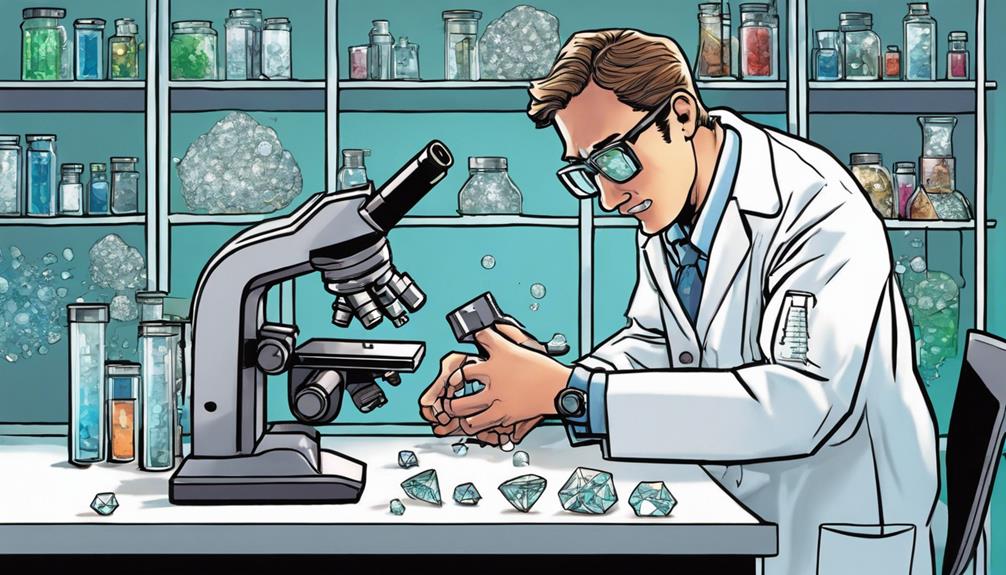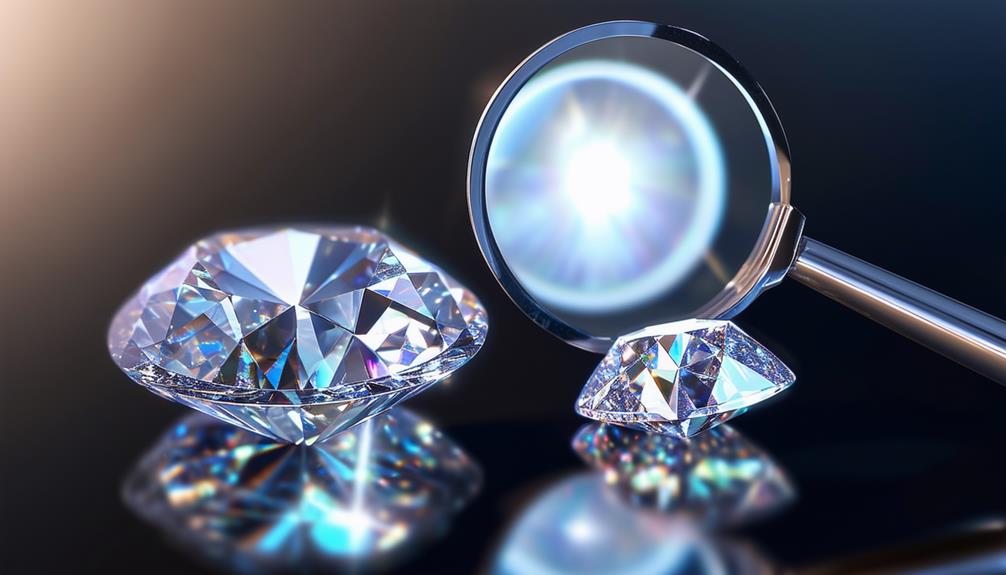Article Contents
When comparing lab-grown diamonds to natural diamonds, it's important to evaluate purity by examining the presence of impurities like nitrogen and boron. These impurities can impact the diamonds' optical properties and their value.
Lab-grown diamonds are typically created using High Pressure High Temperature (HPHT) or Chemical Vapor Deposition (CVD) techniques. Due to the controlled conditions of their creation, lab-grown diamonds usually contain fewer impurities and inclusions, resulting in higher levels of purity.
On the other hand, natural diamonds often contain unique imperfections that contribute to their beauty and can affect their value. Advanced verification methods, such as Raman spectroscopy, play a crucial role in establishing the purity of diamonds, thereby bolstering consumer confidence in their authenticity and quality.
When selecting a diamond, considering these aspects will lead to a more informed decision and a deeper appreciation of the diamond's inherent qualities and elegance. Further exploration into the world of diamonds can provide additional valuable insights.
Key Features
- Lab-grown diamonds often display higher purity due to the controlled conditions of their production, which reduce the presence of impurities.
- Natural diamonds may contain impurities such as nitrogen and boron, which can impact their levels of purity.
- Raman spectroscopy is a vital technique for confirming the purity of both lab-grown and natural diamonds, ensuring precise identification of their composition.
- In comparison to natural diamonds, lab-grown diamonds generally have fewer inclusions, which are typically smaller, leading to a greater level of purity.
- It is crucial to understand the specific impurities and inclusions in diamonds in order to accurately evaluate their market value and verify their authenticity.
Defining Diamond Purity
Diamond purity is key in assessing a diamond's value, defined by the absence of impurities within its crystal structure. The structure not only enhances the diamond's aesthetic appeal but also influences its optical properties and, consequently, its market value. An understanding of diamond purity requires knowledge of how elements like nitrogen or boron may be incorporated into the diamond's lattice, affecting its clarity and colour.
Spectral analysis is a critical method used to evaluate the purity of a diamond by detecting these impurities. This technique provides detailed insights into the diamond's composition, thus highlighting the qualities that determine its grade. For buyers, the clarity of a diamond, ascertained through rigorous examination, offers not only a symbol of pristine beauty but also a choice that meets their specific criteria for both aesthetics and purity.
Diamonds with high purity levels, characterised by minimal to no detectable impurities, are highly valued in the market. Their appeal lies in their consistent colour and brilliance, qualities that make them preferred choices among jewellers and collectors alike.
Impact of Production Methods
The production methods of diamonds, specifically high-pressure high-temperature (HPHT) and chemical vapor deposition (CVD), significantly impact their physical and chemical attributes. These methods are steps towards environmental sustainability and ethical practices within the diamond industry. HPHT simulates the natural environmental conditions of diamond formation by applying intense pressure and heat to carbon, allowing for the creation of diamonds in a controlled environment. In contrast, CVD involves layering carbon atoms from a gas onto a substrate, facilitating the gradual formation of diamonds in a precise and sustainable manner.
| Method | Description |
|---|---|
| HPHT | Applies extreme pressure and heat to carbon to form diamonds. |
| CVD | Builds diamonds by depositing carbon atoms from gas onto a substrate layer by layer. |
These modern techniques not only ensure the consistent quality of lab-grown diamonds but also reduce the negative environmental and social impacts traditionally associated with diamond mining. By opting for diamonds produced through HPHT or CVD methods, consumers support responsible and sustainable practices, aligning their luxury purchases with their ethical and environmental values.
Common Impurities in Diamonds
Understanding the common impurities in diamonds, such as nitrogen and boron, is crucial for assessing their quality and market value. Nitrogen, the most common impurity found in both lab-grown and natural diamonds, can affect the colour and overall appeal of these gems, often resulting in a yellowish tint. Boron, although rarer, imparts a distinctive blue or grey colouration that can increase the rarity and desirability of diamonds.
When comparing lab-grown and natural diamonds, it is clear that lab-grown diamonds typically have fewer impurities due to the controlled conditions of their production. These controlled environments help avoid the inclusion of impurities like sulphur and iron, which are more commonly found in natural environments. Sulphur can give diamonds a yellowish hue, while iron might produce green or brown tints, potentially lowering the colour grade and visual appeal of the stones.
The levels of impurities in diamonds not only influence their appearance but also play a critical role in determining their value in the market. For both enthusiasts and investors, understanding these impurities is essential for making informed decisions that align with preferences for aesthetic quality and intrinsic worth. This knowledge ensures that all stakeholders can trust the valuation and appreciate the unique characteristics of each diamond.
Assessing Types of Inclusion
When assessing types of inclusions, it's important to note that lab-grown diamonds typically contain metallic inclusions, while natural diamonds exhibit a wider range of imperfections like feathers, clouds, or crystals. This distinction is crucial for accurately identifying inclusions and assessing clarity, which significantly impacts consumer choices based on their preferred aesthetic or structural characteristics of diamonds.
Lab-created diamonds, made in controlled environments, generally have fewer and smaller inclusions such as metallic flux residue, graphite, or metal oxides. These inclusions, though less varied, are essential for determining the clarity and quality of these diamonds. Conversely, natural diamonds may contain feathers, which are small cracks that vary widely in size and visibility, affecting both the stone's durability and clarity.
Differences in Purity Grading
The comparison of purity grades between lab-grown and natural diamonds reveals clear differences. Lab-grown diamonds typically showcase higher purity due to the absence of common natural impurities like nitrogen. These diamonds are crafted in controlled environments, allowing for the precise manipulation of conditions to reduce defects. On the other hand, natural diamonds often contain impurities such as nitrogen, boron, or hydrogen, affecting their clarity and purity grade.
These variations in purity impact not only market valuation and standards but also influence consumer preferences and pricing. Individuals prioritising flawless clarity may prefer lab-grown diamonds for their consistently high purity. However, those who appreciate the unique traits of natural stones might choose them for their distinctive imperfections.
Awareness of these differences in purity grades is crucial for consumers, enabling them to make informed choices in a competitive market. Such knowledge assists in selecting diamonds that align with their quality expectations, investment goals, and aesthetic values, ultimately enhancing the purchasing experience.
Influence of Growth Conditions
The growth conditions of diamonds, whether cultivated in a laboratory or mined from the earth, have a significant impact on their purity and structural features. In a lab setting, scientists precisely manage temperature and pressure to replicate the natural formation conditions of diamonds. This precise control allows for the creation of man-made diamonds with specific levels of purity. Temperature is carefully regulated to ensure that crystals develop with few impurities, thereby enhancing their clarity and worth.
Pressure plays a vital role in shaping the crystal structures of diamonds. In natural settings, the immense pressures in the Earth's mantle over extended periods give each diamond distinctive characteristics. Conversely, in a lab environment, precise adjustments to pressure encourage optimal crystal growth, resulting in a more uniform end product. This fine-tuning of growth conditions enables the enhancement of particular characteristics in lab-grown diamonds, such as hardness and colour, potentially equalling or surpassing those of natural diamonds.
By meticulously controlling temperature and pressure during the growth process, notable differences in purity and crystal structure emerge between lab-grown and natural diamonds, impacting their quality and market worth. This detailed approach ensures that lab-grown diamonds can be relied upon to possess qualities comparable to or better than those found in nature, influencing their reception and value in the market.
Purity Verification Techniques

Experts employ various techniques to ensure the purity of both lab-grown and natural diamonds. For lab-grown diamonds, Raman spectroscopy is commonly used. This sophisticated method analyses the diamond's molecular structure to detect trace elements or impurities that might compromise its purity. Each synthetic diamond undergoes this meticulous evaluation to ensure it meets high purity standards before reaching the consumer.
In contrast, natural diamonds are evaluated primarily through visual inspections and certifications issued by accredited gemological laboratories. These labs scrutinise the diamonds for inclusions or other defects that could affect their value. Additionally, isotope analysis is utilised to determine not only the purity but also the geographic origin of natural diamonds, verifying their authenticity and enhancing their value.
Both lab-grown and natural diamonds are subject to rigorous assessment to confirm they meet established purity standards. This thorough verification process supports the diamond industry's commitment to excellence, providing assurance that each gemstone, whether created in a lab or mined, is of high quality. This allows consumers to make informed choices, confident in the quality and authenticity of their diamonds.
Frequently Asked Questions
Do Lab Grown Diamonds Look as Good as Natural Diamonds?
Lab-grown diamonds display the same sparkle and transparency as mined diamonds and provide a cost-effective option. They are attractive to customers who value both appearance and value for money.
Can a jeweller tell the difference between a lab-grown and a natural diamond?
Jewellers can distinguish between lab-grown and natural diamonds using specialised techniques like UV light tests, spectroscopy, and thorough visual inspection. These methods rely on subtle differences in the physical and chemical properties of the diamonds that call for expert knowledge to recognise.
What are the disadvantages of lab-grown diamonds?
Lab-grown diamonds, although having physical properties identical to natural diamonds, have lower investment value as they may lose value more rapidly. Furthermore, there are ethical concerns about the production methods used to create them, which may not always meet high ethical standards. Additionally, these man-made diamonds often lack the historical and emotional charm of natural diamonds, which could affect consumer preferences and reduce market demand.
Can a Diamond Tester Tell the Difference Between Lab Grown and Natural?
A typical diamond tester cannot distinguish between lab-grown and natural diamonds as both types have similar physical properties such as electrical and thermal conductivity. Specialised testing equipment that examines crystal structure or specific inclusions is needed to tell them apart.
Conclusion
In conclusion, the pursuit of determining the purity of diamonds, whether lab-grown or naturally sourced, is a sophisticated practice. This process involves meticulously assessing inclusions, understanding the conditions under which the diamonds formed, and applying advanced techniques for accurate verification.
Such efforts align with both artistic appreciation and scientific inquiry. Despite the origins of lab-grown and natural diamonds, their pristine beauty commands universal admiration, celebrating both human innovation and the enigmatic forces of nature.

